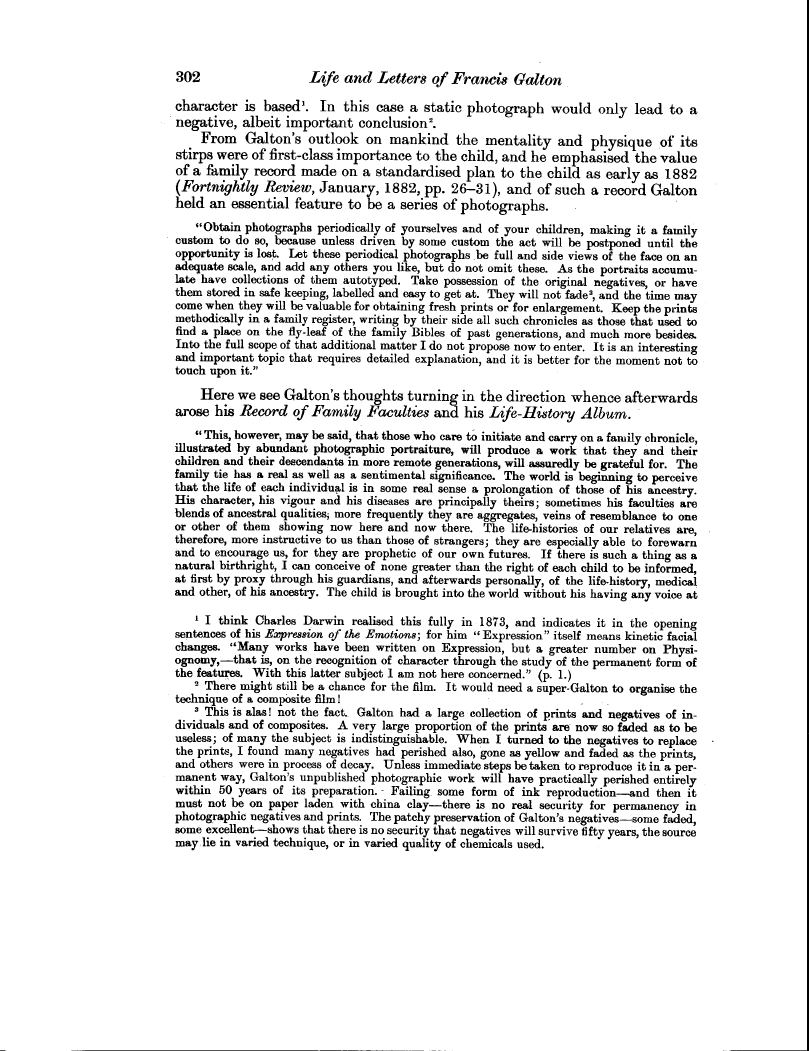held an essential feature to be a series of photographs.
"Obtain photographs periodically of yourselves and of your children, making it a family custom to do so, because unless driven by some custom the act will be postponed until the opportunity is lost. Let these periodical photographs .be full and side views of the face on an adequate scale, and add any others you like, but do not omit these. As the portraits accumulate have collections of them autotyped. Take possession of the original negatives, or have them stored in safe keeping, labelled and easy to get at. They will not fade', and the time may come when they will be valuable for obtaining fresh prints or for enlargement. Keep the prints methodically in a family register, writing by their side all such chronicles as those that used to find a place on the fly-leaf of the family Bibles of past generations, and much more besides. Into the full scope of that additional matter I do not propose now to enter. It is an interesting and important topic that requires detailed explanation, and it is better for the moment not to touch upon it."
Here we see Galton's thoughts turning in the direction whence afterwards arose his Record of Family Faculties and his Life-History Album.
302 Life and Letters of Francis Galton
character is based'. In this case a static photograph would only lead to a negative, albeit important conclusion'.
From Galton's outlook on mankind the mentality and physique of its stirps were of first-class importance to the child, and he emphasised the value of a family record made on a standardised plan to the child as early as 1882 (Fortnightly Review, January, 1882, pp. 26-31), and of such a record Galton
"This, however, may be said, that those who care to initiate and carry on a family chronicle, illustrated by abundant photographic portraiture, will produce a work that they and their children and their descendants in more remote generations, will assuredly be grateful for. The family tie has a real as well as a sentimental significance. The world is beginning to perceive that the life of each individual is in some real sense a prolongation of those of his ancestry. His character, his vigour and his diseases are principally theirs; sometimes his faculties are blends of ancestral qualities; more frequently they are aggregates, veins of resemblance to one or other of them showing now here and now there. The life-histories of our relatives are, therefore, more instructive to us than those of strangers; they are especially able to forewarn and to encourage us, for they are prophetic of our own futures. If there is such a thing as a natural birthright, I can conceive of none greater than the right of each child to be informed, at first by proxy through his guardians, and afterwards personally, of the life-history, medical and other, of his ancestry. The child is brought into the world without his having any voice at
1 I think Charles Darwin realised this fully in 1873, and indicates it in the opening sentences of his Expression of the Emotions; for him " Expression" itself means kinetic facial changes. "Many works have been written on Expression, but a greater number on Physiognomy,-that is, on the recognition of character through the study of the permanent form of the features. With this latter subject I am not here concerned." (p. 1.)
2 There might still be a chance for the film. It would need a super-Galton to organise the technique of a composite film !
3 This is alas! not the fact.. Galton had a large collection of prints and negatives of individuals and of composites. A very large proportion of the prints are now so faded as to be useless; of many the subject is indistinguishable. When I turned to the negatives to replace the prints, I found many negatives had perished also, gone as yellow and faded as the prints, and others were in process of decay. Unless immediate steps be taken to reproduce it in a permanent way, Galton's unpublished photographic work will have practically perished entirely within 50 years of its preparation. - Failing some form of ink reproduction-and then it must not be on paper laden with china clay-there is no real security for permanency in photographic negatives and prints. The patchy preservation of Galton's negatives-some faded, some excellent-shows that there is no security that negatives will survive fifty years, the source may. lie in varied technique, or in varied quality of chemicals used.

